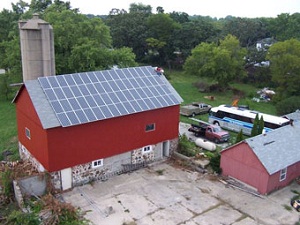USDA: More farmers harvesting solar, wind to power farms
 While they’re called wind or solar farms because the power they produce is harvested for use elsewhere, traditional farms are also increasingly homes to photovoltaics and other forms of renewable-energy generation for use onsite. In a first-of-its-kind report last month, the United States Department of Agriculture (USDA) found that by the end of 2009, just shy of 8,000 farms across the nation had installed photovoltaic systems to offset their energy use.
While they’re called wind or solar farms because the power they produce is harvested for use elsewhere, traditional farms are also increasingly homes to photovoltaics and other forms of renewable-energy generation for use onsite. In a first-of-its-kind report last month, the United States Department of Agriculture (USDA) found that by the end of 2009, just shy of 8,000 farms across the nation had installed photovoltaic systems to offset their energy use.
The report found that the use of solar and wind on farms is growing.
“Clearly the report says the demand for these facilities is growing; it’s growing dramatically,” said National Farm Union President Robert Johnson.
While farms also have leased land to utilities and power producers, this report covers smaller systems installed by farmers for their own use.
“Basically, they’re generally talking about 100-kilowatt facilities—or less—in size,” Johnson said. “So these are on-farm use facilities.”
In all, 8,569 farms reported using renewable energy generation, including solar, wind and methane digesters, to produce energy. The farmers responded to USDA’s “2009 On-Farm Renewable Energy Production Survey.”
Of the total respondent farms, 7,968 farms said they installed photovoltaics or solar thermal to offset energy use on their farms. Solar was the most popular choice among farmers and the only one used in all 50 states, far outpacing the 1,420 wind installations across 48 states. Methane digesters were a distant third, with 121 farmers in 29 states installing them.
The survey determined that California had the most solar installations with 1,906 systems installed. Texas was second with 537 solar installations. Perhaps surprisingly, Hawaii was third with 520 solar installations, edging out Colorado which had 504 solar installations, the survey found.
“At each of the states where it’s growing the largest, every one of those states has a renewable energy standard, or some sort of state-sanctioned goal to increase the production of renewable energy,” Johnson said. “States adopting these standards give [farmers] some certainty that there will be a market for them.”
"These results indicate that farmers and ranchers are increasingly adopting renewable energy practices on their operations and reaping the important economic and environmental benefits," U.S. Agriculture Secretary Tom Vilsack said in a press release. “This survey gives us a benchmark against which we can measure our future successes."
Farmers in states with net-metering provisions were more apt to install a larger system, according to Johnson.
“Those state policies make an impact. States without net metering are likely to put in smaller systems because the excess energy isn’t really worth much,” he said.
The survey also showed that the majority of farmers with renewable energy systems were saving money on their utility bills thanks to the installations. The average energy savings were $2,406 in 2009 utility costs. However, New York farmers reported saving an average of $5,067 in 2009 utility costs.
Image courtesy of the Wisconsin Distributed Resources Collaborative, Inc.



